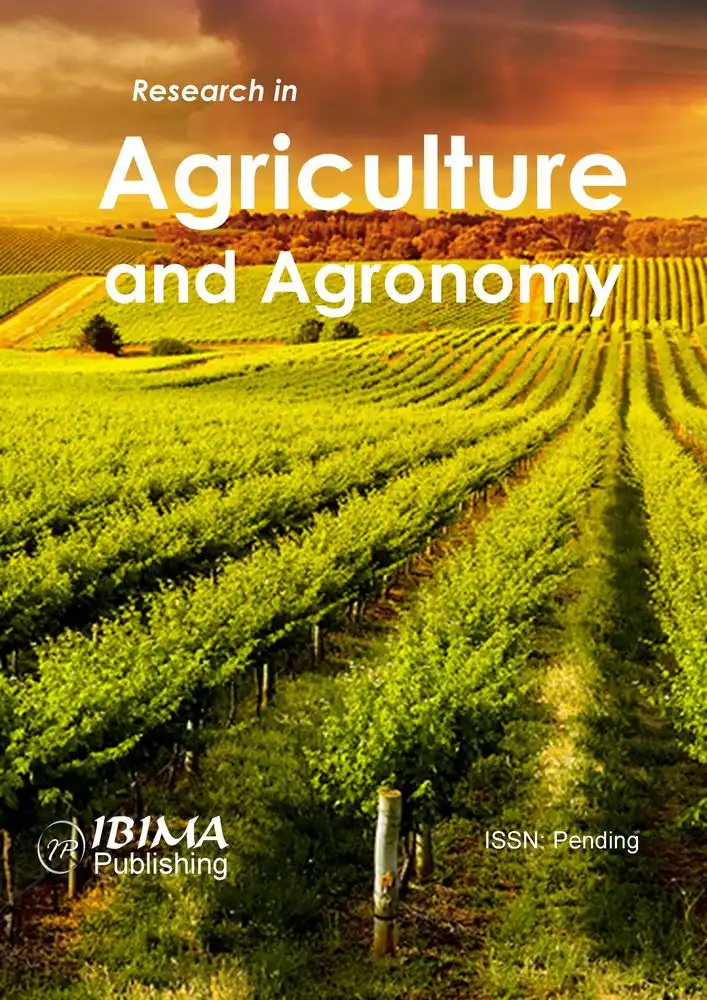Introduction
Fish are vertebrate animals that make up the most important link in trophic chains in aquatic basins. Without fish, many animal species would no longer survive, and billions of people would be affected by the lack of food resources. The national territory has significant water resources, which, in the conditions of sustainable exploitation, ensured sufficient food resources for the population, the need for drinking water for the population or the needs of the agricultural sector. Research on the evolution of the fish species in the Republic of Moldavia has shown in recent years the reduction of natural and artificial water, mainly due to pollution, to an irrational exploitation or poaching and this happens widely at the national level.
Short Literature Review
The research carried out by Bulat (2017), concerning the fish species in the main rivers of the Republic of Moldavia, showed from the point of view of rarity (Pelecus cultratus, Leuciscus idus, Barbus meridionalis petenyi, Vimba vimba, Apro streber, Lota lota). The Prut is much better represented compared to the Nistru River, which shows an even more pronounced anthropogenic impact in the border area with Ukraine compared to that of Romania. In both rivers, intensive fishing has strongly affected migratory and semi-migratory fish species, or high-lifelong large-scale fisheries, which have almost disappeared from the catches of Moldavian fishermen. Strategies related to the use of imported fisheries species in the population of national waters must be carefully analyzed and ecologically based. In aquaculture fish ponds in Moldavia, they are frequently seen bloodydue to the ameliorative effect on the “flowering of water” phenomenon or the bitch which reduces the water flowing with macrophytic organisms. These species, although desirable in fish catches and have beneficial economic returns, can have invasive effects, and fish farmers who use them must have at least one advantageous strategy under particular environmental conditions (Munteanu and Stanciu, 2017).
A slight improvement in the status of indigenous fish species has been seen lately in the Prut and Nistru ecosystems. Bulat (2017) justifies the growth of rapacious carp, catfish and perch populations as effects of decaying of riverbeds or as a positive reaction to the development of short-lived species destined for with predilection feeding of rapists. The studies conducted by Curcubeţ (2016) highlighted the fact that although there were some measures of restocking in the Dubăsari aquatic basin, the natural fish balance is rebuilding hard, the fish fauna can be restored for short periods of time and repeated and grounded measures are needed to obtain satisfactory results. Intervention measures on affected aquatic basins should include several species of fish in proportions close to natural equilibrium levels, which must be monitored and balanced by periodic interventions. Thus, attempts to restore the ecosystem through repopulation can only favor some fish species (in the case of Dubăsari carp and crucian), to other species such as raptors with reductions in flocks, due to inadequate monitoring and lack of regular intervention measures to complement the fishery resources and to correct the natural balance.
Large-scale poaching during prohibition, non-selective tree cuts (with intensification of the erosion processes of the riverbed), stunning burning, sand extraction from the riverbed (under the pretext of deepening and straightening), oil pollution, unlawful acquisition of game animals, storage of landfills in the flood plain of the Prut or the extension of land for agricultural purposes up to the bank of the river, without respecting protection strips, are factors that have significantly affected the Prut riverfish (Bulat, et al., 2014). Intervention on riverbeds, intensive extraction of construction materials (sand, gravel), construction of ports or other works done without a proper assessment of the impacts on fisheries resources can lead to ecological disasters, with the disappearance of fish species and favoring the development of others. Usatîi et. (2013) stated that at the Prut and Nistru rivers, the warping and the increase of the water mineralization due to some landscaping works favored the development and diversification of the short life cycle fish species (Gobiidae, Gasterosteidae, Sygnathidae) to the detriment of others. In the aquatic basins of these rivers, the reduction of water quality and the disturbance of the natural equilibrium were favored by eutrophication phenomena specific to the stagnant waters, manifested by the enrichment of water in nitrogen and / or phosphorus compounds, the accelerated growth of algae or other higher forms of vegetation, and enrichment of organic mass. The instability of environmental conditions in river ecosystems can affect the development of valuable fish species, and the food chain can be interrupted at the level of short life cycle species. The results are visible at the food chain level, and the effects on the human diet can be significant (Bulat, 2011). An importantfeature of food industry is that producers, in order to cope with market needs and legal requirements, have to satisfy both safety and quality criteria for their products.
Materials and Methods
The information on the evolution of the fish species from the natural ihtiofauna of the Republic of Moldavia was collected from specialized articles, fundamental and applied research and background articles. The collected data were ordered, processed and graphically presented. The results obtained were compared with other data from the literature for an appropriate interpretation.
Natural Fish Potential
According to the hydrographic maps elaborated by the National Agency of Moldavian Waters (2017), the Moldavian national territory has few large rivers, but it is characterized by a network of 3621 permanent or temporary water courses. The total length of the Moldavian hydrographic network, which belongs to the Black Sea basin, exceeds 16,000 km, cumulating a total flow of about 1,32 billion m3/year. Of the total running water, only eight rivers (Nistru, Prut, Răut, Bîc, Botna, Ichel, Cogîlnic and Ialpug) have a length of more than 100 km, 247 rivers with courses of more than 10 km length. Due to the general inclination of the relief of the republic, the big rivers Nistru and Prut have the flow direction from northwest to southeast. Small rivers, tributaries on the left bank of the Nistru and the Prut, or rivers flowing southwards to the republic in the lakes of the Danube and the Black Sea basins have different directions. The hydrographic zoning of the Republic of Moldavia comprises 4 drainage basins: the Nistru River covers 67% of the area, the Prut 24%, and the other two hydrographic basins representing about 9%, and are constituted by the tributaries of the Danube, flowing directly into the Black Sea. Many rivers in the national territory are affected by clogging and dryness during the warm season, Moldavia’s main source of drinking water supply is groundwater sourceswhich serve 65% of the country’s population (100% of the rural population and 30 % of the urban one). More than 53 water reserves and about 1,600 lakes (ponds) were built on the national territory to assure the need for water, especially for agriculture and fish farming, which join the 3500 natural lakes in the hydrographic network. Ichthyological investigations on rivers and lakes in the Republic of Moldavia are long-term studies, requiring significant personnel and financial resources. Although there is a number of research in the field, the full characterization of fish fauna continues to be of interest to the academic environment. Determining the ideofaunistic diversity can be achieved by using different methods. A widely used variant for assessing the diversity of fish stocks is the general degree of anthropogenic damage and the presence of species at a particular point of collection. Through this method, some ecological niches can be highlighted, which have been reserved for different species from the evolutionary point of view. The method is useful, but the results have a higher degree of confidence in less polluted areas. Another method used to assess the quality of the aquatic ecosystem is to overlay an anthropically unaffected biotope with a specific structure over another biotope with a real structure. The comparison made allows the evaluation of the structural – functional evolution in natural conditions and in those affected by different factors. The Nistru River Basin covers 57% of the country’s territory, the river having an annual flow of about 10 km³, marks a 630-km-long border between the Republic of Moldavia and Ukraine. The Nistru, named after the “amber road” since ancient times, is characterized by a specific zoning of fish diversity. The results of the scientific researches carried out in 2008 by the Institute of Zoology of the Academy of Sciences of the Republic of Moldavia in the Lower Nistru region revealed the presence of only 39 species and fish subspecies from 12 families (sterlet, pike, roach, clean, bream, carp, novac, silver carp, perch and others). Research conducted by Bulat (2017) over the years 2006-2017 highlighted the predominance of 75 taxons, belonging to 11 orders and 18 families (Figure 1).
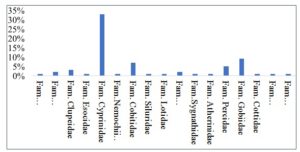
Fig. 1: Ichtiofauna of the Nistru River (%)
Source: Author, using data from Munteanu (2017).
The area of lowland of the river is characterized by a high diversity of fish species which leads to high quality catches and good economic productivity. Compared with the downstream, the upstream area of the river has significantly lower natural resources. Overall, the fish fauna of the Nistru River is represented by about 130 species, comprising between 46 and 94 taxons.
The fish fauna of the Prut River, where the native fish species predominate (European catfish, common barbel or romanian barbel, european carp, common nase, burbot) is predominantly influenced by the natural conditions, characterized by the presence of deep pits in the riverbed, the meanders of the course or poor water transparency. The analysis of the variation of fish population densities, based on annual data, shows that if in the 1970s in the Prut River, 95 species and fish subspecies lived, of which in the Republic of Moldavia – 86, in 2008 only 69 species were found species and subspecies (Figure 2).
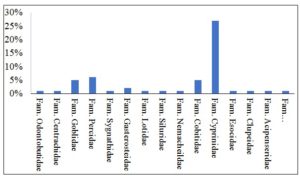
Fig. 2: Isochyofauna of the Prut River (%)
Source: Author, using data from Munteanu (2017)
Studies conducted by Bulat (2017) showed a reduction in the Prut River fish stock represented in 2016 by only 56 species of fish framed in 10 orders and 15 families. The total number of small rivers with permanent or temporary flow from the national network of the Republic approaches 3100. Due to the large modifications of the water regime and the high thermal conductivity, the small rivers in the hydrographic network of Moldavia are characterized by a low fish population. In the literature on fish species in the Republic of Moldavia, the contribution of small rivers to the national fisheries fund is frequently neglected. Research made by Bulat et al. (2014), show differences in quantification of the number of small-scale fish species, depending on the researcher. Thus, if the research carried out by Tomnatic (1962) highlighted a very low idiophaunistic diversity in the small rivers and reservoir lakes, the number of species identified by Usatîi (2000) or by Bulat et al (2014) is significantly higher (Figure 3). According to Tomnatic (1962), 24 species of fish from 6 families were identified on the small rivers, without taking into account the species populated for economic purposes (plaid, shawl and the coregon of the Ciudsk), most of the catches are considered non-valuable food. The research conducted by Usatîi (2000) between 1997 and 2000 revealed a greater diversity of fish species. The phenomenon is explained by Bulat et al (2014) through acclimatization actions of species considered of perspective, the penetration and self-exposure of naturalized alien and interventional species, or especially the process of greening small rivers by reducing the content of pesticides, fuels and other persistent pollutants actively used during the Soviet period. Recent research by Bulat et al (2014) shows the change in the number of species on the studied rivers, mainly under the influence of the anthropic factor.
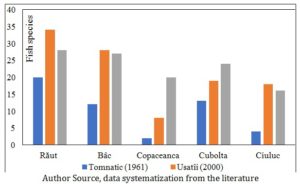
Fig. 3 : Fish species in small rivers in Moldavia (by years and citation sources)
Author Source, data systematization from the literature
From this point of view, it can be considered that although the diversity of small-scale rivers is mainly determined by the abiotic conditions specific to each water course, the anthropic factor manifested through direct or indirect impacts is the most important element affecting the ecosystems of flowing waters which are small in the territory of the republic. Capture and use of water for other uses, the collection or destruction of plants and aquatic animals especially those included in the Red Book, all lead to the disruption of the development of natural flora and fauna. Although the national territory has significant natural resources, their exploitation is ineffective as the national food market depends on the imports of fishery products.
Biological improvement of Moldavian aquatic ecosystems with fish species by restocking
The restoration of the fish population in affected areas can be achieved through artificial populations with indigenous imported species. In order to reduce the surplus of macrophyte biomass and to reduce the effects of active eutrophication, aquaculture studies recommend the use of ameliorative species (chest and bloody). Recommendations on poppy brood rules largely depend on climatic zone conditions, hydrochemical gradients, or trophic potential in the ecosystem, as shown in Table 1.
Table 1: Popular standards with ameliorative species on reservoir lakes

Source: Data processing from Ihtiofauna of the Republic of Moldavia, Munteanu (2018).
To reach the near-required values of ecosystem restoration, annual fish stock populations of 13.6 tonnes are recommended for the Ghidighici reservoir and 131 tonnes for the Dubăsari reservoir (Figure 4).

Fig. 4: Annual fish stock of repopulation with fish in national lakes
Source: Author, using data from Munteanu (2018)
For economic reasons, it is recommended to perform restocking actions every three years with the tripling of the normed quantities provided that the Moldavian fishery producers can offer enough fish for the population. Annually, popular fish stocks are made in order to supply fish stocks in natural
fish ponds. Figure 5 shows that the 2005-2007 years which were the most productive years of purchasing funding projects for fish brood populations. In the year 2016, a project amounting to 1,290,000 MLD, financed by the National Ecological Fund was initiated for the purchase of 39.4 tons of fish juveniles.
Reproduction of fish stocks at national level
The Republic of Moldavia is making considerable efforts to preserve the aquatic biological potential and diversity, to protect them and to develop fishing and fish farming in the natural aquatic objectives within the territorial limits of the republic. According to the Law of the Republic of Moldavia no. 149 of June 8, 2006, the natural aquatic objectives are considered to be the Nistru with its tributaries, the Dubăsari reservoir, the Cuciurgan reservoir, the Turunciuc arm, the Prut River with its tributaries, the Costeşti-Stânca reservoir, the ponds Manta, the Beleu and Cahul lakes. The restocking actions carried out in the main reservoirs of the Republic of Moldavia are shown in Figure 5.

Fig. 5: Reproduction of fish juveniles in the main lakes of the Republic of Moldavia
Author Source, Data Processing of the Fisheries Service (2008-2017)
Figure 5 does not quantify data from years in which no value was reported for restocking actions. The management of natural resources and the protection of aquatic biological resources in the mentioned basins are the responsibility of the Ministry of Ecology and Natural Resources, which through the Fisheries Service exercises state supervision on the observance by the natural and legal persons of the legislation regulating this type of activity.
Repopulations in Dubăsari Lake
Dubăsari Lake is one of the largest lakes in the Republic of Moldavia. The reservoir was artificially created between 1954 and 1956 by the Soviet authorities on the middle course of the Nistru River with the objective of producing electricity. At present, there is a clogged aquatic basin where changes are observed throughout the biota of the basin and its sectors. In the lake they found 35 species and fish subspecies grouped in 8 families, of which only 12 species and fish subspecies are of economic interest (pike, big oak, carp, tench, rapacious carp, breams, Silver carp, Bighead carp or Grass carp, catfish). Other 7 species have a high economic value (roach, crucian carp, clean, scabbard, amur carp, bat, perch) while the rest of the species can not be considered economically. A reduced annual water temperature, fluctuations in the hydrological regime, shortening the length of fish fattening periods, or increased water transparency have favored the intensive growth of aquatic vegetation that has affected the development of valuable economic species and negatively influenced the effectiveness of natural reproduction. The accumulation lake is the fish-fattening basin, and the Nistru media is used for reproduction. Fish phytochemicals, due to the cold water spill from Novodnestrovsk Lake, are no longer using the midlands Nistru, the areas of Lake Dubăsari are insufficient for development.
Overpopulation of the lake and the strong floods of the years 2008 and 2010 have reduced the area of the lithophilous fish species. Excessive growth of aquatic plants on the crops used reduced the reproduction areas for marsh, gull, dwarf, cob, and allowed the use of reproductive surfaces by unpretentious species adapted to lowering the water temperature oscillations.
Population of the Dubăsari reservoir with valuable species of fish species in argued amounts can contribute to the improvement of the state of the fish resources and will significantly reduce the plant density, being considered a biological improvement of the clogged basin. The dynamics of juvenile populations in the period 1998-2017 is shown in Figure 6. The main species targeted to restore the natural balance were: carp, crucian carp, bighead carp, silver carp.

Fig. 6: Population of Dubăsari reservoir with fish brood
Source: Author, Data Processed from the Fisheries Service (1998-2010)
In 2008, the Dubăsari reservoir was populated with 14,000 kg of fish brood (bighead carp, silver carp, breams and carp), with a total value of 420,000 MDL. A new re-population with fish as an initiative of the Moldavian Fisheries Service took place on April 16-29, 2012, 20,500 kg of juvenile carp, bream, bighead and silver carp species being released in the lakes. The third major stage, run in 2016, aimed at re-populating 26,200 kilos of the Dubăsari Lake, the project was financed entirely from the National Ecological Fund sources.
Repopulations in Stânca Costești Lake
The accumulation lake at Costești, located on the Prut River, is the second largest in the republic after Dubăsari. Formed in energetic goal in 1976, through a partnership agreement between the Socialist Republic of Romania and the Moldavian Soviet Socialist Republic, is located on the middle course of Prut, with a total area of 5.9 thousand ha, of which about 2.1 – 2.6 thousand of Ha in the Republic of Moldavia. According to common ischiotic researches carried out by the Fisheries Service and scientific institutions in the area, 26 species and fish subspecies grouped in 6 families have been recorded in the lake waters over the past five years. If in 1980 the species of small fish were predominant, systematic populations in the quantities recommended with carp, shalam and plaice saplings offered the possibility of increasing the larger species, with the stabilization of the quantitative and qualitative composition of the ichthyofauna. At the end of the 1990s, the volume of commercial fishing catches decreased by 6.6 times, mainly due to the cessation of systematic populations of carp and grass carp seedlings and the failure to ensure normal conditions for natural reproduction caused by diurnal oscillations of water in the lake. The influence of abiotic and biotic factors and poor management of fishery resources have led to a considerable reduction in the number of fish species of high economic value. The variations in water level in the lake during the period of prohibition of fishing due to flow regulation which is the result of the construction and exploitation of the Costești – Stânca hydroelectric node and the inefficient boistea, led to a decrease in the level of reproduction of the valuable fish species in the lake and the numerical quantity of the mature slope of the populations. The dynamics of juvenile populations in the period 1998-2017 is shown in Figure 7. The main species used to restore the natural balance were perch, crucian and breams.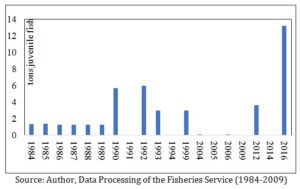
Fig. 7: Population of the accumulation Costesti-Stânca lake with fish brood
Source: Author, Data Processing of the Fisheries Service (1984-2009)
Figure 7 only quantified where the juvenile population used for restocking was expressed in mass units without being represented in cases where hatched eggs or aphids were used. For example, between 1984 and 2009, more than 133 million larvae and alveoli were used with a perch-dominated distribution (Figure 8).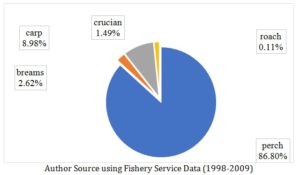
Fig. 8: FIsh species used for the population of Stânca Costeşti Lake (1984-2009)
Author Source using Fishery Service Data (1998-2009)
The restocking with larvae, alveoli or numerically quantified juveniles continued and in in 2011, the employees of the Fisheries Service released in the Costesti – Stânca accumulation lake about 2.3 million specimens of breams larvae (Abramis brama L.) in order to maintain and increase theses species in the lake. In 2014, the Republic of Moldavia’s Fisheries Service received 2 million embryonated caviar eggs from the genetic pool of Razelm Lake in Tulcea county which were used for the population of Costeşti – Stânca Lake.
Conclusions
The Republic of Moldavia is a country that has a diversified natural fishery fund, in which species adapted to the natural biotope predominate. Lately the human factor has negatively influenced the fauna and has led to changes in the balance of natural water systems. The Republic of Moldavia has multi-annual programs for the re-population of the main fishing areas, which will likely have positive effects through the rehabilitation of the fish fauna in an average time, with the reduction of poaching and the application of measures to reduce the effects of pollution. Considering that the main watercourses are also border areas with the neighboring countries, it would be advisable to carry out cross-border projects in this direction, which would further support the restoration of the natural habitats and the fish population in the Nistru and Prut rivers. For the sustainable use of water resources, it is advisable to restore the natural wetlands of the rivers andclean the bed of the main tributaries of the Nistru and Prut rivers both to facilitate fish migration and to prevent the adverse consequences of floods that may lead to changing the share of some local species. Some rivers can be turned into tourism areas or aquaculture farms can be set up with rising fish quantities, thus reducing the availability of imports from other countries.
(adsbygoogle = window.adsbygoogle || []).push({});
References
- Agenția națională ”Apele Moldovei” (National Agency”Apele Moldovei”), (2017), Harta hidrografică a Republicii Moldova, [online]. [Retrieved February 18, 2018], http://www. apelemoldovei.gov.md/lib.php?l=ro&idc=188
- Bagrin N., Bileţchi L., Bogonin Z., Borodin N., Ungureanu, L., Zubcov E., (2014), Dinamica indicilor hidrotegnici și calitatea apei râului Prut, Institutul de Zoologie al Academiei de Ştiinţe a Moldovei, Chișinău, pp.103-110 [online]. [Retrieved February 18, 2018], https://ibn.idsi.md/sites/default/files/ imag_ file/Dinamica%20indicilor%20 hidrochimici.pdf
- Bulat Dn., Bulat, Dm., (2011), Sinteza postulatelor ce caracterizează starea ihtiofaunei râurilor mici din Republica Moldova, Institutul de Zoologie al AŞM, Chișinău [online]. [Retrieved February 14, 2018], https://ibn.idsi.md/sites/default/ files/imag_file/Sinteza%20postulatelor%20ce%20 caracterizeaza_0.pdf
- Bulat Dn., Dm., (2011), Sinteza postulatelor ce caracterizează starea ihtiofaunei râurilor mici din Republica Moldova, Institutul de Zoologie al AŞM, Chișinău [online]. [Retrieved March 18, 2018], https://ibn.idsi.md/sites/default /files/imag_file/Sinteza%20postulatelor%20ce%20caracterizeaza_0. pdf
- Bulat Dn., Bulat, Dm., Toderaș I., Usatîi M., Zubcov E., Ungureanu L., (2014), Biodiversitatea, Bioinvazia și Bioindicația, Monografie, Chișinău [online]. [Retrieved February 1, 2018], https://www. researchgate.net/publication/314238784_biodiversitatea_bioinvazia_si_bioindicatia_in_studiul_faunei_piscicole_din_Republica_Moldova/overview.
- Bulat, Dtru., Bulat D., Toderaș I., Usatîi M., Fulga N., Dumbraveanu D., Rusu V., Silitrari A., (2013), Potențialul invaziv al speciilor de pești și factorii determinanți ai ihtiogenozelor ecosistemelor acvatice din Republica Moldova, Institutul de Zoologie al Academia de Ştiinţe a Moldovei, Universitatea de Stat din Moldova, Chișinău [online]. [Retrieved February2018], https://ibn.idsi.md/sites/ default/files/imag_file/Potentialul%20 invaziv%20al%20speciilor%20de%20pesti%20%C5%9Fi%20factorii%20determinanti %20ai% 20ihtiocenozelor. pdf.
- Moșu A., Trombițki I., (2013), Peștii Nistrului de Mijloc și de Jos, Ghid al păstrătorilor râurilor, Chișinău [online]. [Retrieved January 29, 2018], http://renasterearurala.vox.md/ wpcontent/uploads/2014/02/pestii_nistrului_de_ mijloc_si_de_jos.pdf
- Munteanu (Pila), M., Stanciu, S., (2017), Preliminary Research Concerning the Fisheries Sector Potential of the Republic of Moldova, The 30th International-Business-Information-Management-Association Conference, (Madrid, Spain, Nov. 08-09, 2017), Vols I-IV, ISBN: 978-0-9860419-9-0, 2405-2415.
- Munteanu (Pila), M., Stanciu, S., 2018, Evolution and Measures of the Fish Fauna Recovery in the Republic of Moldova, 31st IBIMA Conference: Innovation Management and Education Excellence through Vision 2020 (25-26 April 2018, Milan, Italy), http://ibima.org/accepted-paper/evolution-and-measures-of-the-fish-fauna-recovery-in-the-republic-of-moldova.
- Tumanova, D., (2016) Algele planctonice în monitoringul biologic al stării ecosistemelor fluviale și lacustre, Ihtiologie, Hidrobiologie, Chișinău [online], [Retrieved February 18, 2018], http://www.cnaa.md/files/ theses/ 2016/ 50800/daria_tumanova_thesis.pdf
- Usatîi M., (2004) Evoluţia, conservarea şi valorificarea durabilă a diversităţii ihtiofaunei ecositemelor acvatice ale Republicii Moldova. Autoreferat al tezei de doctor habilitat în ştiinţe biologice, Chişinău, [online]. [Retrieved February 25, 2018], https://ibn.idsi.md/ sites/default/files/imag_file/97_105_Recoma nd%C4%83ri%20privind%20protec%C5% A 3ia%20%C5%9Fi%20valorificarea%20diversit%C4%83%C5%A3ii%20ihtiofaunei%20% C3%En%20ecosistemele%20antropizate.pdf
- Томнатик Е.Н., Владимиров М.З., Карлов В.И.,(1964), The ichthyofauna of the small reservoirs of Moldavia and the ways of its directional change. В: Biological resources of reservoirs of Moldova (Original russian Ихтиофауна малых водохранилищ Молдавии и пути ее направленного изме- нения. В: Биологические ресурсы водоемов Молдавии, Bып. 2. Изд. Картя молдовеня- скэ. Кишинев), pp.131–151.
- Rotaru,G., Sava,N., Borda, D., Stanciu, S., (2005), Food quality and safety management systems: a brief analysis of the individual and integrated approaches, Jurnal Scientifical Researches: Agroalimentary Processes and Technologies, 11(1), pp. 229-236
- Munteanu (Pila), M., Stanciu, S., (2017) Preliminary Research Concerning the Fisheries Sector Potential of the Republic of Moldova, Proceedings of the 30th IIBIMA Conference, Vision 2020: Sustainable Economic Development, Innovation Management, and Global Growth, VOLS I-IV (1), (Madrid, Spain, Nov. 08-09), Edited by: Soliman, KS, pp. 2405-2415,



